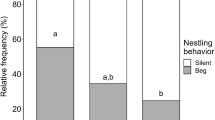Abstract
The searching behavior of two coccinellid beetles of the genusChilocorus (Coccinellidae: Coleoptera) was compared. The main components of the searching behavior of larvae and adults - speed of search and change of angle before and after successful encounter with hosts - were compared within and between species. Both species (at the larval and adult stages) changed their searching behavior following successful encounter, by increasing the angle and number of turns per unit of time. These changes were coupled with reductions in the speed of locomotion. The intensity of the changes differed significantly between the species.C. bipustulatus demonstrated a stronger response in the degree of change in angle thanC. kuwanae. As time elapsed and unsuccessful search continued, the beetles returned to their original pattern of search. Both species allocated an increasing proportion of their time to patches of hosts, in accordance with host density.
Similar content being viewed by others
References
Banks, C.J. (1954) The searching behaviour of coccinellid larvae.Anim. Behav. 2:37–38.
Banks, C.J. (1957) The behaviour of individual coccinellid larvae on plants.Anim. Behav. 5:12–24.
Carter, M.C. and Dixon, A.F.G. (1982) Habitat quality and foraging behaviour of coccinellid larvae.j. Anim. Ecol. 51:865–878.
Cody, ML. (1971) Finch flocks in the Mohave desert.Theor. Popul. Biol. 2:142–158.
Cody, ML. (1974) Optimization in ecology.Science, N.Y. 183:1156–1164.
Cook, R.M. and Hubbard, S.F. (1977) Adaptive searching strategies in insect parasites.J. Anim. Ecol. 46:115 -125.
Dixon, A.F.G. (1959) An experimental study of the searching behaviour of the predatory coccinellid beetleAdalia decempunctata (L.).J. Anim. Ecol. 28:259–281.
Fleschner, C.A. (1950) Studies on searching capacity of the larvae of three predators of the citrus red mite. Hilgardia20:233–265.
Formanowicz, D.R. Jr. (1982) Foraging tactics of larvae ofDytiscus verticalis (Coleoptera: Dytiscidae): The assessment of prey density.j. Anim. Ecol. 51:757–767.
Hassell, M.P. (1966) Evaluation of parasite or predator responses.J. Anim. Ecol. 42:693–736.
Hassell, M.P. and Southwood, T.R.E. (1978) Foraging strategies of insects. A. Rev. Ecol. Syst.9:75–98.
Hubbard, S.F. and Cook, R.M. (1978) Optimal foraging by parasitoid wasps.J. Anim. Ecol. 47:593–604.
Kamburov, S.S., Nadel, D.J. and Kenneth, R. (1967) Observations onHesperomyces virescens Thaxter, a fungus associated with premature mortality ofChilocorus bipustulatus L.Israel J. agrie. Res. 17:131–136.
Laing, J. (1938) Host finding by insect parasites. II. The chance ofTrichogramma evanescens finding its hosts.j. exp. Biol. 15:281–302.
Mitchell, B. (1963) Ecology of two carabid beetles,Bembidion lampros (Herbst) and.Trechus quadristriatus (Schrank). I. Life cycles and feeding behaviour.j. Anim. Ecol. 32:289–299.
Murdie, G. and Hassell, M.P. (1978) Food distribution, searching success and predatorprey models,in: Hiorns, R.E. [Ed.] The Mathematical Theory of the Dynamics of Biological Populations, pp. 87–101. Academic Press, London.
Nadel, D.J: and Biron, S. (1964) Laboratory studies and controlled mass rearing ofChilocorns bipustulatus L., a citrus scale predator in Israel.Riv. Parassit. 25:195–206.
Podoler, H. and Henen, J. (1983) The effects of constant temperatures on developmental time and survival of two coccinellid beetles of the genusChilocorus: A comparative study.Phytoparasitica 11:167–176.
Pyke, G.H., Pulliam, H.R. and Charnov, E.L. (1977) Optimal foraging, a selective review of theory and tests.Q. Rev. Biol. 52:137–154.
Sokal, R.R. and Rohlf, E.J. (1969) Biometry. W.H. Freeman & Company, San Francisco, CA.
Stamp, N.E. (1982) Searching behaviour of parasitoids for web-making caterpillars: A test of optimal searching theory.j. Anim. Ecol. 51:387–395.
Storch, R.H. (1976) Prey detection by 4th stageCoccinella transversoguttata (Coleoptera: Coccinellidae),Anim. Behav. 24:690–693.
Stubbs, M. (1980) Another look at prey detection by coccinellids.Ecol. Ent. 5:179–182.
Waage, J.K. (1978) Arrestment responses of the parasitoidNemeritis canescens to contact chemical products by its host,Plodia interpunctella.Physiol. Ent. 3:135–146.
Waage, J.K. (1979) Foraging for patchily-distributed hosts by the parasitoid,Nemeritis canescens.J. Anim. Ecol. 48:353–371.
Author information
Authors and Affiliations
Rights and permissions
About this article
Cite this article
Podoler, H., Henen, J. Foraging behavior of two species of the genuschilocorus (coccinellidae: coleoptera): a comparative study. Phytoparasitica 14, 11–23 (1986). https://doi.org/10.1007/BF02980474
Received:
Revised:
Issue Date:
DOI: https://doi.org/10.1007/BF02980474




